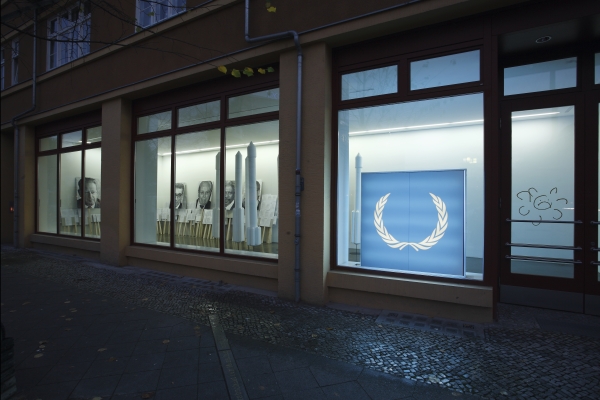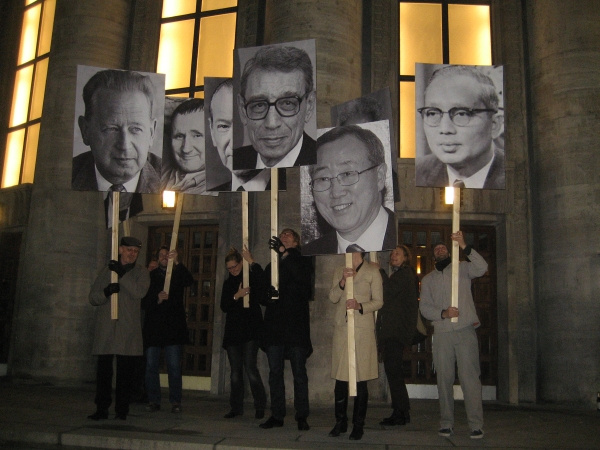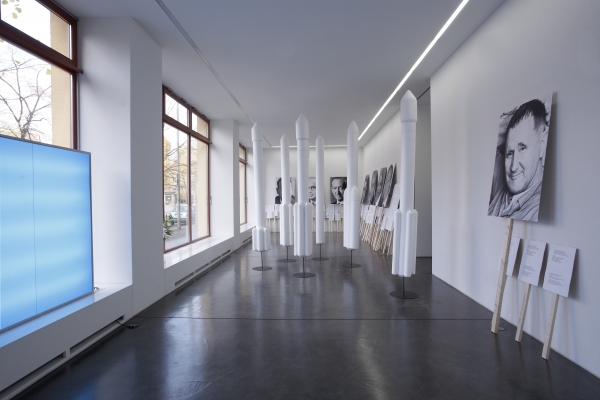
Exterior view with "Peace for Outer Space" (2008), Galerie Christian Nagel, Berlin
Exterior view with "RESOLUTIONs" posters, Galerie Christian Nagel, Berlin
Performance of "RESOLUTIONs" in front of Galerie Christian Nagel, Berlin, 29 October 2008
Performance of "RESOLUTIONs" in front of the Volksbühne theater, Berlin, 29 October 2008
Performance of "RESOLUTIONs" in front of the Babylon theater, Berlin, 29 October 2008
Installation view, Galerie Christian Nagel, Berlin
Installation view, "Launch Vehicles" (2008), Galerie Christian Nagel, Berlin
Installation view, "Space Rendezvous" (2008), Galerie Christian Nagel, Berlin
Installation view, "United Nations Souvenirs" (2008), Galerie Christian Nagel, Berlin
Performance on the night of the United States Presidential Election, Rosa-Luxemburg-Platz, Berlin, 1 November 2008
RESOLUTIONs
30 October – 20 December 2008
Galerie Christian Nagel, Berlin
Gallery Installation:
“RESOLUTIONs,” 2008
- “Resolution der Kommunarden,” 2008; Wood, cardboard, and paper
- “50 Jahre (109) UN-Resolutionen ‘Peaceful Use of Outer Space,’” 2008; wood, cardboard, and paper
- “Launch Vehicles,” 2008; Painted polystyrene, 7 rockets, approx.188 inches each
- “Peace for Outer Space,” 2008; Lightbox, 61 x 61 x 7.8 inches
- “United Nations Souvenirs,” 2008; Mixed media, 4 pieces, 19.6 x 23.6 inches each
- “Space Rendezvous,” 2008; color/sound, 5.58 minutes, DVD and UN flag
Performance:
- Eight performers with “Resolution der Kommunarden,” Rosa-Luxemburg-Platz, Berlin, 29 October 2008
Müller conceived “RESOLUTIONs” as an exhibition in two parts: a gallery installation consisting of sculptures, a video, and photographs; and a performance in the public plaza in front of the gallery. Referring directly to the 2008 financial crash and subsequent lack of faith in governmental power structures as systems of social support, “RESOLUTIONs” connects history with the present, local and world policies, as well as private, public, and outer space by appropriating imperialistic and colonial images and relating them to symbols of globally acting power structures.
This exhibition followed closely after Müller’s performance “Space-Rendezvous” for Manifesta 7 two months prior, which referred to the Cold War “Apollo Soyuz” project to unite capitalism and communism by means of adjoining U.S. and Soviet spacecraft in outer space (called a “space rendezvous”) in July 1975. For this installation, Müller continued to investigate methods used to control and assert ownership of outer space at the United Nations Office for Outer Space Affairs (UNOOSA) in Vienna — the sole UN committee responsible for promoting international cooperation in the peaceful uses of outer space.
The objects and documents Müller created for “RESOLUTIONs” relate to the mission and activities of the UNNOOSA, which were united by the artist’s use the UN flag with the image of the globe removed. In its place, Müller collaged images of outer space and documentation of his visit to the exhibitions at UNOOSA’s office in Vienna (“United Nations Souvenirs”) as well as video documentation of his Manifesta 7 “Space Rendezvous” performance. Illuminating the gallery’s storefront, “Peace for Outer Space,” a lightbox containing the UN logo without the globe made light of the slippage between branding merchandise (the fashion label Fred Perry located nearby has a nearly identical logo) and structures intended to keep peace. Müller filled the gallery’s central space with scaled models of “launch vehicles” — phallic symbols of aggression used by international space programs — that are on display in Vienna. By rendering them in Styrofoam and removing painted flags and insignia, Müller humorously removes their violent nationalist intentions while referring to the Office’s mission to “launch peace.”
Along the gallery walls, Müller lined large placards with the heads of UN Secretary Generals, whose faces are little known to the public despite their use of power on a global and extra-terrestrial scale, alongside the image of Bertoldt Brecht, whose poem “Resolution der Kommunarden” was used in the title of the installation. Interspersed between the faces, the artist included updates of the last 50 years of UN resolutions for peace in outer space, beginning with the first in 1958, in the five original languages of the UN (Chinese, English, French, Russian, and Spanish).
These placards resemble preparations (or leftovers) of a public demonstration, which the artist intended as a reference to Swedish artist Öyvind Fahlström, who organized a “happening” in New York in 1966 entitled “Kisses Sweeter than Wine” during which seven people carried posters of the American comedian Bob Hope and a photo of Mao Tse-tung. With this action, Fahlström juxtaposed two contrasting ideologies, represented by the portraits of the popular protagonists of both systems.
On the show’s opening night, 29 October 2008, eight performers “hijacked” Müller’s exhibition by taking the placards of the Secretary Generals onto the street in front of the gallery in homage to Fahlström. Processing around Berlin’s Rosa-Luxemburg-Platz (named after the Marxist heroine), the group stopped at the headquarters of the German Linke (Left) party, the Volksbühne theater, and the Babylon movie theater. By moving out of the gallery and into public space, the artist questioned the imagined “fourth wall” of the stage and screen as it compared to the four walls of the white cube, while demonstrating the similarity between theater spectacles and state, international, and outer space politics.
A second spontaneous “performance” happened on the night of 1 November 2008, several nights before the election of U.S. President Barack Obama, when a crowd of Obama supporters converged on Rosa-Luxemburg-Platz for a staged event complete with choreographed dances, music, American flags, cameras, lights, and bleachers for a large audience. Müller joined the festivities with the image of Brecht, connecting his installation with the spectacle of contemporary U.S. politics.
Text by Cara Jordan








